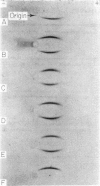Abstract
The low molecular weight cobra venom factor (CoVF) was used to activate the terminal sequence of the alternative complement pathway in thirty-one sera from patients with sickle cell disease (SCD). The SCD sera were compared with normal sera as a source of the alternative complement pathway factors C3 proactivator (C3PA) and C3PA convertase. These factors are required for formation of the enzymatically active CoVF-C3PA complex which is capable of cleaving C3 and thus initiating generation of the cytolytic C5b-9 complex. CoVF cofactor activity was significantly less than normal in SCD sera as measured in an indirect lysis assay, indicating reduced C3PA or C3PA convertase activity in these sera. Qualitative (immunoelectrophoresis) and quantitative (radial immunodiffusion) measurement of C3PA showed, however, that this protein is normal or elevated in SCD sera. Taken together, the reduced CoVF cofactor activity and normal or elevated C3PA in SCD sera suggests that sera from patients with sickle cell disease have reduced C3PA convertase activity.
Full text
PDF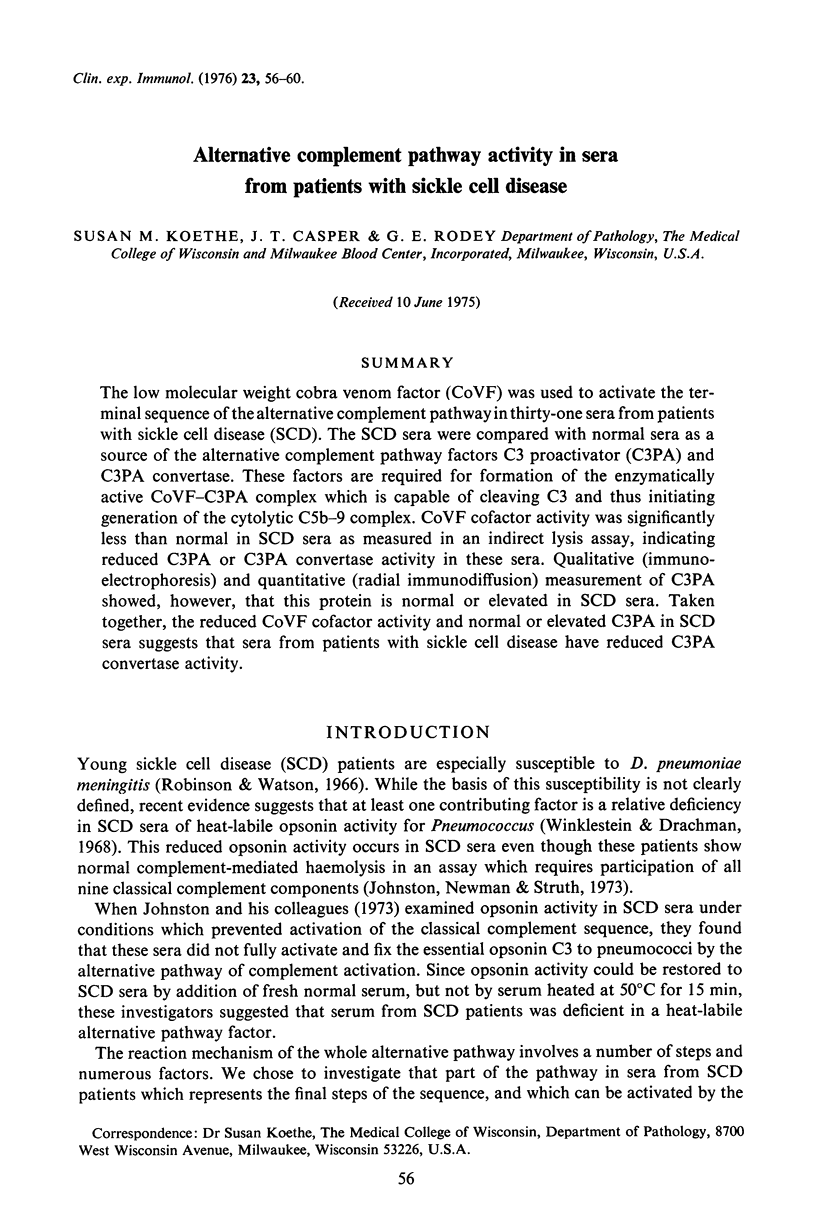
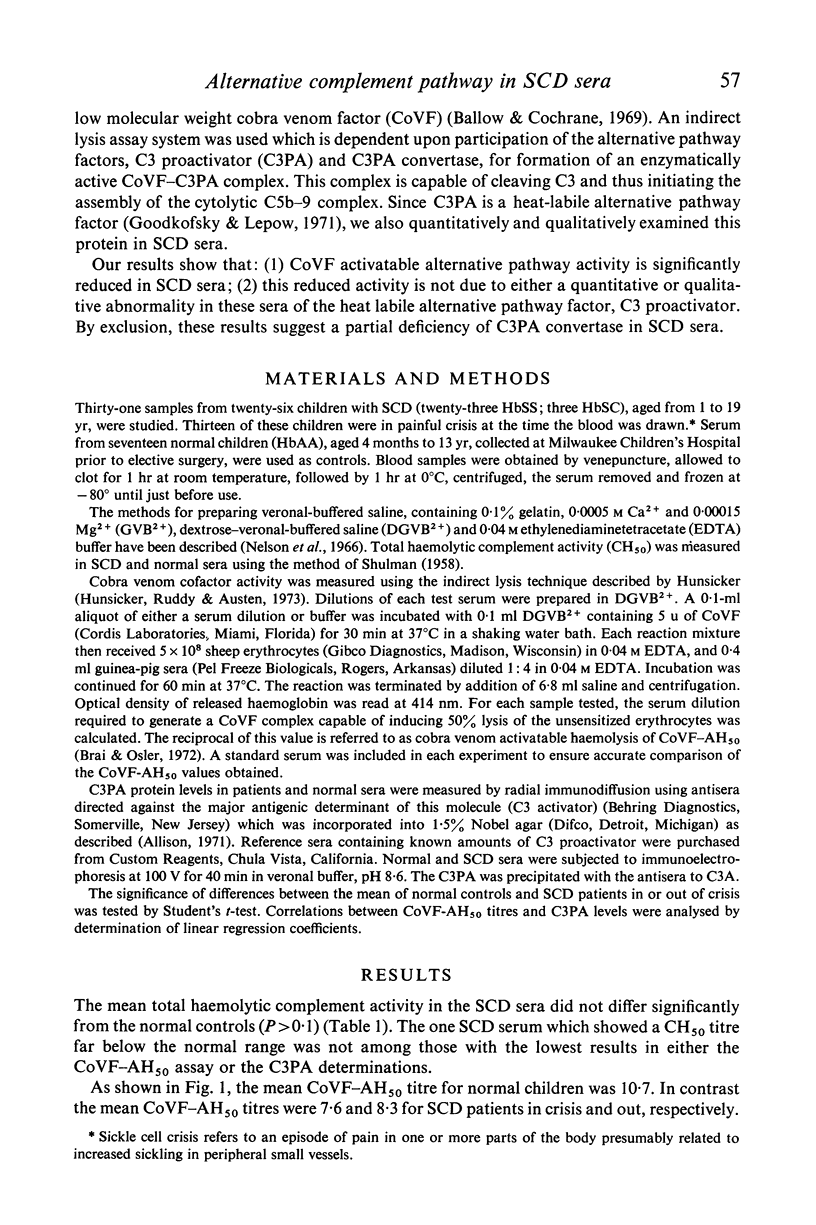
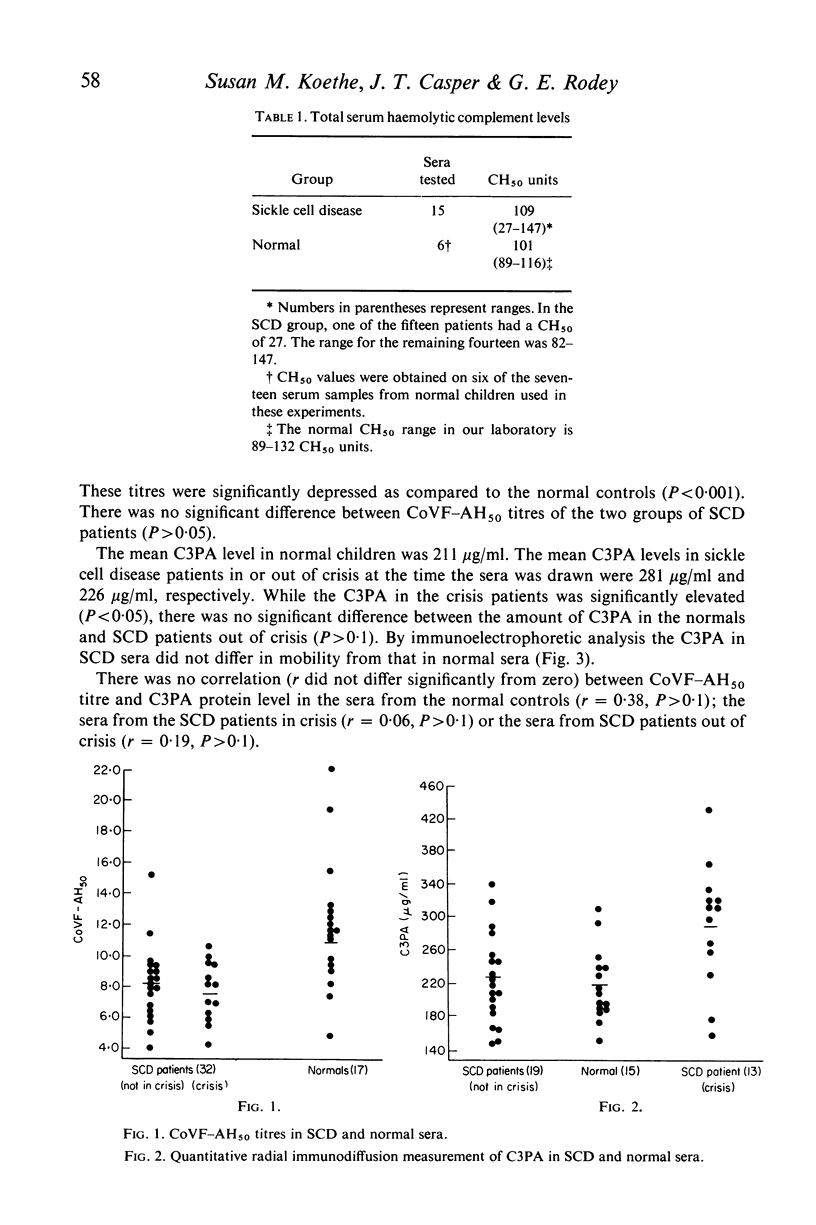
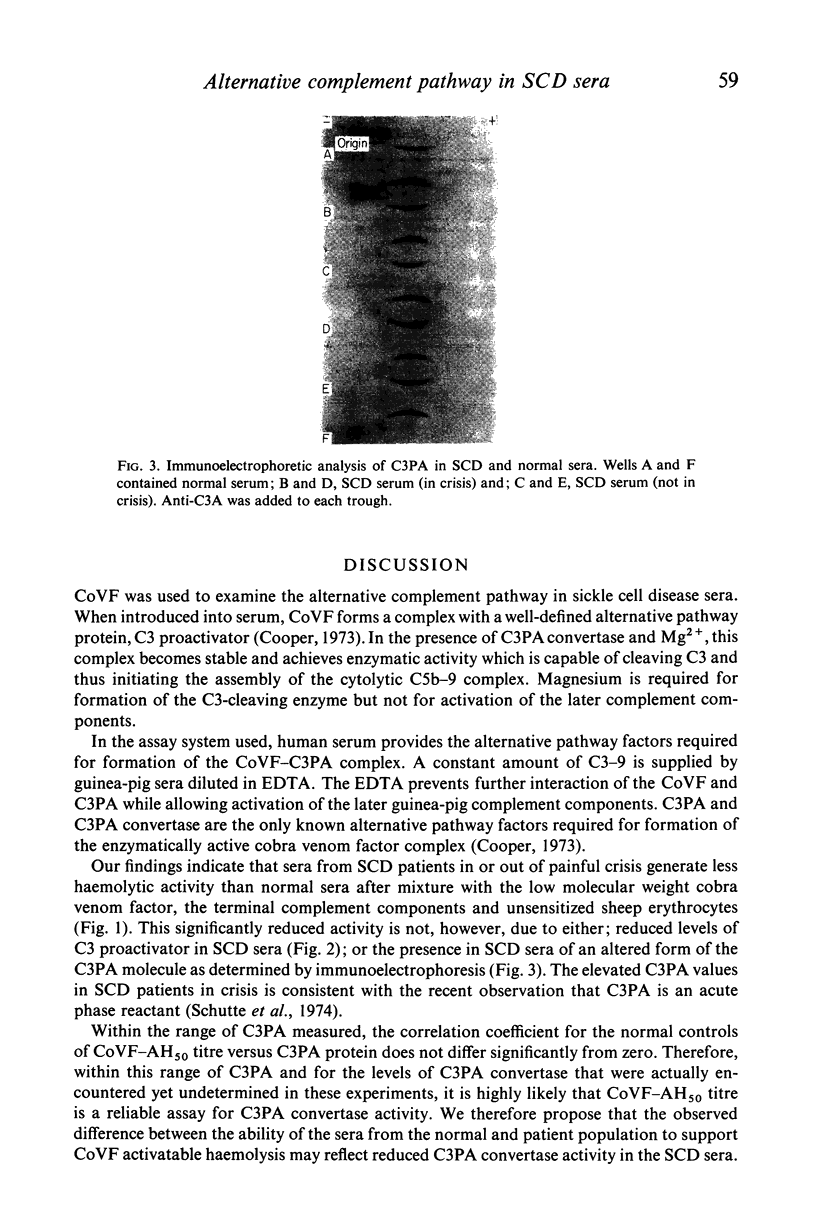
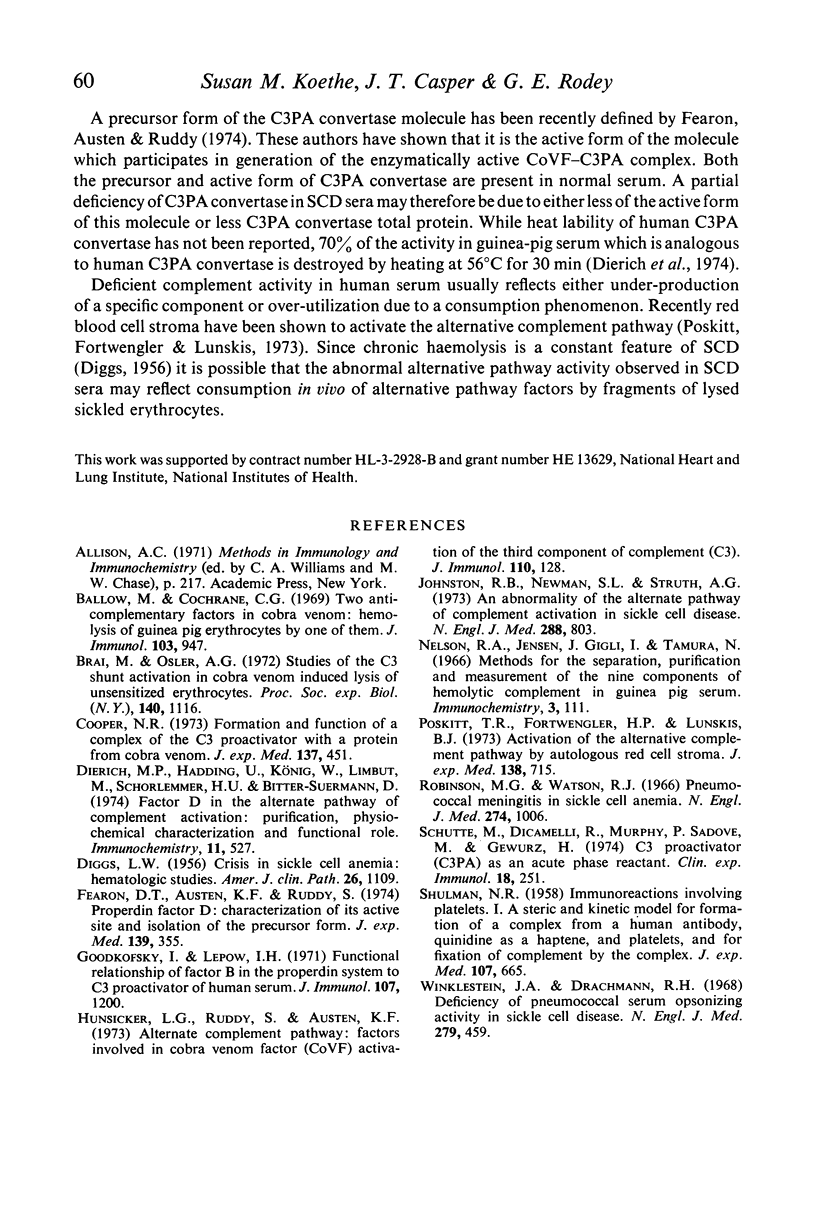
Images in this article
Selected References
These references are in PubMed. This may not be the complete list of references from this article.
- Brai M., Osler A. G. Studies of the C3 shunt activation in cobra venom induced lysis of unsensitized erythrocytes. Proc Soc Exp Biol Med. 1972 Jul;140(3):1116–1121. doi: 10.3181/00379727-140-36623. [DOI] [PubMed] [Google Scholar]
- Cooper N. R. Formation and function of a complex of the C3 proactivator with a protein from cobra venom. J Exp Med. 1973 Feb 1;137(2):451–460. doi: 10.1084/jem.137.2.451. [DOI] [PMC free article] [PubMed] [Google Scholar]
- DIGGS L. W. The crisis in sickle cell anemia; hematologic studies. Am J Clin Pathol. 1956 Oct;26(10):1109–1118. doi: 10.1093/ajcp/26.10.1109. [DOI] [PubMed] [Google Scholar]
- Dierich M. P., Hadding U., König W., Limbert M., Schorlemmer H. U., Bitter-Suermann D. Factor D in the alternate pathway of complement activation: purification, physicochemical characterization and functional role. Immunochemistry. 1974 Sep;11(9):527–532. doi: 10.1016/0019-2791(74)90242-0. [DOI] [PubMed] [Google Scholar]
- Fearon D. T., Austen K. F., Ruddy S. Properdin factor D: characterization of its active site and isolation of the precursor form. J Exp Med. 1974 Feb 1;139(2):355–366. doi: 10.1084/jem.139.2.355. [DOI] [PMC free article] [PubMed] [Google Scholar]
- Goodkofsky I., Lepow I. H. Functional relationship of factor B in the properdin system to C3 proactivator of human serum. J Immunol. 1971 Oct;107(4):1200–1204. [PubMed] [Google Scholar]
- Hunsicker L. G., Ruddy S., Austen K. F. Alternate complement pathway: factors involved in cobra venom factor (CoVF) activation of the third component of complement (C3). J Immunol. 1973 Jan;110(1):128–138. [PubMed] [Google Scholar]
- Johnston R. B., Jr, Newman S. L., Struth A. G. An abnormality of the alternate pathway of complement activation in sickle-cell disease. N Engl J Med. 1973 Apr 19;288(16):803–808. doi: 10.1056/NEJM197304192881601. [DOI] [PubMed] [Google Scholar]
- Nelson R. A., Jr, Jensen J., Gigli I., Tamura N. Methods for the separation, purification and measurement of nine components of hemolytic complement in guinea-pig serum. Immunochemistry. 1966 Mar;3(2):111–135. doi: 10.1016/0019-2791(66)90292-8. [DOI] [PubMed] [Google Scholar]
- Poskitt T. R., Fortwengler H. P., Jr, Lunskis B. J. Activation of the alternate complement pathway by autologous red cell stroma. J Exp Med. 1973 Sep 1;138(3):715–722. doi: 10.1084/jem.138.3.715. [DOI] [PMC free article] [PubMed] [Google Scholar]
- Robinson M. G., Watson R. J. Pneumococcal meningitis in sickle-cell anemia. N Engl J Med. 1966 May 5;274(18):1006–1008. doi: 10.1056/NEJM196605052741806. [DOI] [PubMed] [Google Scholar]
- SHULMAN N. R. Immunoreactions involving platelets. I. A steric and kinetic model for formation of a complex from a human antibody, quinidine as a haptene, and platelets; and for fixation of complement by the complex. J Exp Med. 1958 May 1;107(5):665–690. doi: 10.1084/jem.107.5.665. [DOI] [PMC free article] [PubMed] [Google Scholar]
- Schutte M., DiCamelli R., Murphy P., Sadove M., Gewurz H. C3 proactivator (C3PA) as an acute phase reactant. Clin Exp Immunol. 1974 Oct;18(2):251–256. [PMC free article] [PubMed] [Google Scholar]
- Winkelstein J. A., Drachman R. H. Deficiency of pneumococcal serum opsonizing activity in sickle-cell disease. N Engl J Med. 1968 Aug 29;279(9):459–466. doi: 10.1056/NEJM196808292790904. [DOI] [PubMed] [Google Scholar]



